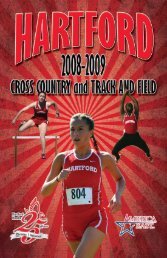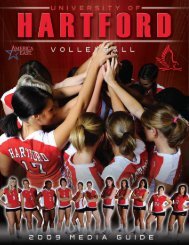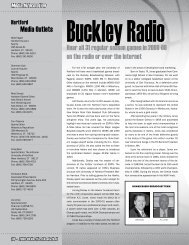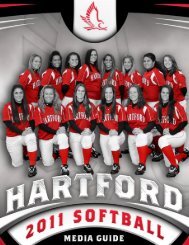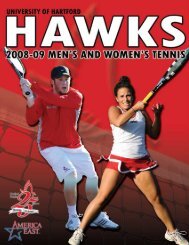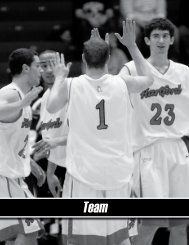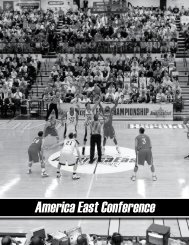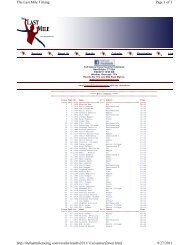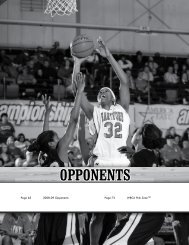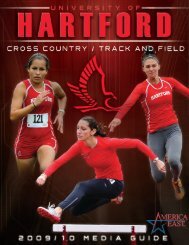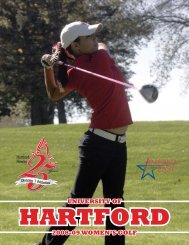Click Here to Download a Complete PDF Guide - Hartford Hawks
Click Here to Download a Complete PDF Guide - Hartford Hawks
Click Here to Download a Complete PDF Guide - Hartford Hawks
You also want an ePaper? Increase the reach of your titles
YUMPU automatically turns print PDFs into web optimized ePapers that Google loves.
2009 <strong>Hartford</strong> <strong>Hawks</strong> MEN’S SOCCER<br />
34<br />
University President Walter Harrison<br />
Walter<br />
Harrison<br />
University<br />
President<br />
Growth, vitality, and service<br />
<strong>to</strong> the community are<br />
key attributes of Walter<br />
Harrison’s first 10 years as<br />
president of the University<br />
of <strong>Hartford</strong>. Since his appointment<br />
as the University<br />
of <strong>Hartford</strong>’s fifth president<br />
in 1998, the University has<br />
experienced a period of<br />
energy and momentum unmatched<br />
in its his<strong>to</strong>ry. President<br />
Harrison has overseen<br />
dramatic improvements in<br />
academic quality, finances,<br />
and fundraising.<br />
More than 7,300<br />
students (5,600 undergraduates<br />
and 1,700<br />
graduate students) study at<br />
the seven schools and colleges<br />
of the University of <strong>Hartford</strong>,<br />
which is classified as a doc<strong>to</strong>ral<br />
research–intensive university by<br />
the Carnegie Foundation for the<br />
Advancement of Teaching. The<br />
institution has seen a 15 percent increase in undergraduate enrollment,<br />
and a 23-percent increase in degrees awarded, over the past decade.<br />
A highly visible figure on campus, President Harrison is known for<br />
his enthusiasm for student life and University activities, and is fondly<br />
referred <strong>to</strong> as Walt by many students.<br />
During President Harrison’s tenure, the University has undertaken<br />
a vigorous and comprehensive building campaign. Many of the University’s<br />
residence halls have been renovated, and Hawk Hall, the University’s<br />
new five-s<strong>to</strong>ry, 208-bed residence for first-year students,<br />
was completed during the summer of 2007. The oval-shaped Alumni<br />
Plaza, constructed out of concrete of various colors and finishes, now<br />
provides students with a large gathering spot on the residential side<br />
of campus.<br />
At the heart of this construction campaign are three major<br />
new additions <strong>to</strong> the University’s signature academic programs:<br />
The Renée Samuels Center of the <strong>Hartford</strong> Art School (opened in<br />
January 2007), the Integrated Science, Engineering, and Technology<br />
Complex (opened in 2005), and the Mort and Irma Handel<br />
Performing Arts Center (opened in September 2008), which houses<br />
the Dance and Theatre divisions of The Hartt School. The Handel<br />
Center, located in the Upper Albany and Blue Hills neighborhoods<br />
of <strong>Hartford</strong>, one mile east of the University’s campus, also contains<br />
space for community activities.<br />
Two buildings have been renovated <strong>to</strong> house two of the University’s<br />
leading liberal arts programs: Psychology (East Hall) and<br />
Communications and Cinema Studies (Abrahms Hall). In 2006, the<br />
University opened new state-of-the-art athletic fields for soccer, lacrosse,<br />
softball, and baseball.<br />
The University’s vibrant relationship with the Greater <strong>Hartford</strong><br />
community is a hallmark of President Harrison’s tenure. The University<br />
has become a recognized leader in helping <strong>to</strong> improve public<br />
schools. It is the only private university in the country with two public<br />
magnet schools on campus—the University of <strong>Hartford</strong> Magnet<br />
School and the University High School of Science and Engineering.<br />
President Harrison’s community involvement is extensive. He<br />
serves on the boards of direc<strong>to</strong>rs of the Connecticut Conference of<br />
Independent Colleges and the <strong>Hartford</strong> Consortium of Higher Education.<br />
He is currently the president of the board of the <strong>Hartford</strong> Stage<br />
Company. He serves as trustee or direc<strong>to</strong>r of a number of other <strong>Hartford</strong>-area<br />
organizations, including the Greater <strong>Hartford</strong> Arts Council,<br />
Saint Francis Hospital and Medical Center, the Connecticut Science<br />
Center, and Suffield Academy. He is also a direc<strong>to</strong>r of WorldBusiness<br />
Capital, an international finance firm based in <strong>Hartford</strong>.<br />
Reflecting his longtime interest in intercollegiate athletics, President<br />
Harrison chairs the National Collegiate Athletic Association’s<br />
Committee on Academic Performance, the group charged with implementing<br />
academic reforms among the nation’s leading intercollegiate<br />
athletic programs, and serves on a number of other NCAA committees.<br />
He is the immediate past chair of the NCAA Executive Committee. He<br />
also serves on the Presidential Advisory Committee of the Association<br />
of Governing Boards.<br />
All this is a long way from President Harrison’s beginnings as a<br />
scholar of American literature and culture. A native of Pittsburgh, he<br />
graduated from Trinity College in <strong>Hartford</strong> in 1968, then earned a<br />
master’s degree from the University of Michigan in 1969. After an<br />
interim of three years <strong>to</strong> serve as a captain in the United States Air<br />
Force, President Harrison earned a doc<strong>to</strong>rate from the University of<br />
California–Davis. His doc<strong>to</strong>ral dissertation, “Out of Play: Baseball Fiction<br />
from Pulp <strong>to</strong> Art,” was one of the earliest scholarly treatments of<br />
baseball and its place in American life.<br />
In 1982 President Harrison left full-time teaching <strong>to</strong> take an administrative<br />
position at Colorado College. He joined Gehrung Associates<br />
University Relations Counselors in 1985, becoming president of<br />
the firm shortly thereafter. In 1989 President Harrison moved <strong>to</strong> the<br />
University of Michigan, where he became vice president of university<br />
relations and secretary of the university.<br />
President Harrison and his wife, Dianne, a scholar of 19th-century<br />
Vic<strong>to</strong>rian literature and mystery literature, make their home in Russell<br />
House, the president’s residence at the University of <strong>Hartford</strong>.



